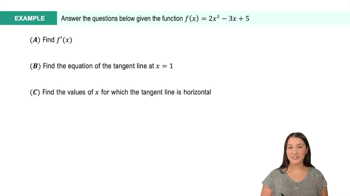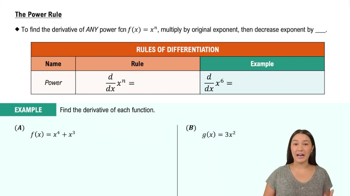Table of contents
- 0. Functions7h 52m
- Introduction to Functions16m
- Piecewise Functions10m
- Properties of Functions9m
- Common Functions1h 8m
- Transformations5m
- Combining Functions27m
- Exponent rules32m
- Exponential Functions28m
- Logarithmic Functions24m
- Properties of Logarithms34m
- Exponential & Logarithmic Equations35m
- Introduction to Trigonometric Functions38m
- Graphs of Trigonometric Functions44m
- Trigonometric Identities47m
- Inverse Trigonometric Functions48m
- 1. Limits and Continuity2h 2m
- 2. Intro to Derivatives1h 33m
- 3. Techniques of Differentiation3h 18m
- 4. Applications of Derivatives2h 38m
- 5. Graphical Applications of Derivatives6h 2m
- 6. Derivatives of Inverse, Exponential, & Logarithmic Functions2h 37m
- 7. Antiderivatives & Indefinite Integrals1h 26m
3. Techniques of Differentiation
Basic Rules of Differentiation
Problem 3.2.27b
Textbook Question
21–30. Derivatives
b. Evaluate f'(a) for the given values of a.
f(t) = 1/√t; a=9, 1/4
 Verified step by step guidance
Verified step by step guidance1
Step 1: Identify the function f(t) = \frac{1}{\sqrt{t}} and recognize that you need to find its derivative, f'(t).
Step 2: Rewrite the function in a form that is easier to differentiate: f(t) = t^{-1/2}.
Step 3: Use the power rule for differentiation, which states that if f(t) = t^n, then f'(t) = n \cdot t^{n-1}. Apply this to f(t) = t^{-1/2}.
Step 4: Calculate the derivative: f'(t) = -\frac{1}{2} \cdot t^{-3/2}.
Step 5: Evaluate f'(t) at the given values of a. First, substitute a = 9 into f'(t) to find f'(9), and then substitute a = \frac{1}{4} into f'(t) to find f'(\frac{1}{4}).
Recommended similar problem, with video answer:
 Verified Solution
Verified SolutionThis video solution was recommended by our tutors as helpful for the problem above
Video duration:
5mPlay a video:
Was this helpful?

 3:59m
3:59mWatch next
Master Derivatives of Linear Functions with a bite sized video explanation from Callie
Start learningRelated Videos
Related Practice







